THERE WERE SCOPITONES - ANCESTORS OF TODAY'S MUSIC VIDEOS

Scopitone films are the 1960s ancestors of today's music videos. They were distributed on color 16mm film with a magnetic soundtrack, and were made to be shown on a Scopitone film jukebox or Cine-Box. The first Scopitones were made in France around 1960, and the Scopitone craze spread throughout Europe (particularly in West Germany and England) before crossing the Atlantic to the United States in mid-1964. By the end of the 1960s, they were gone – but not forgotten by music fans!
I recently presented a 1960s scopitones film festival at the library where I work, compiling some of the best scopes from my personal collection into a one-hour program that was part of our "Roctober" music celebration. It was attended by a whopping audience of one (wither the hipsters?). Oh well, following are the program notes.
*******************************************************************
Program Guide
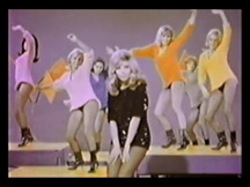
These Boots Are Made For Walking (Nancy Sinatra)
It’s go-go bootcamp time! Pretty girls, long legs, sexy go-go boots and Nancy Sinatra’s sultry-sassy vocals add up to the textbook-cool Great American Scopitone.
Wonder Boy (Leslie Gore)
Crybaby Leslie Gore (“Cry Me a River,” “It’s My Party and I’ll Cry if I Want To”) sings the praises of a studious would-be beau named “Wonder Boy,” who appears to have pioneered the post-modern Nerd Look later made hip by Weezer’s Rivers Cuomo and the Verizon “Can You Hear Me Now?” Guy.

Pussycat A-Go-Go (Stacy Adams)
Bikini-boppin’ Stacy Adams and an unidentified band do the Twist and other moves in this fun-spirited dance party filmed around a pool.


Queen of the House (Jody Miller)
Chorines in teddies with feather dusters highlight this equal opportunity “answer song” to Roger Miller’s hit “King of the Road” in which Ms. Miller sings “Up every day at six bacon and eggs to fix/Four kids from one to four pretty soon there'll be one more/I got old floors to wax and scrub and there's a dirty old ring in the tub/I'll get a maid someday but till then I'm queen of the house.”
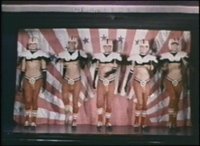
Mr. Touchdown (The Touchdown Girls)
The Touchdown Girls were actually dancers from the Crazy Horse Saloon, and they illustrate why football is followed so passionately in America.

Quando Quando (The Kessler Twins)
“When, when?” the multilingual, statuesque Kessler Twins (frauleins Alice and Ellen) ask - when will their true love come to them? Born in Germany, Die Kessler Zwillinge became renowned dancers in Paris in the 50s, moved to Italy in 1960 to begin their recording career, and later appeared as dancers in the 1963 Hollywood film Sodom and Gomorrah. Curiously, in 1976 at the age of 40, they agreed to pose on the cover of the Italian edition of Playboy – which became the fastest selling issue up to that point.

Web of Love (Joi Lansing)
TV and B-movie star Joi Lansing was named "Miss Armed Forces Day Of The World" in 1967 and starred in such drive-in fare as HILLBILLIES IN A HAUNTED HOUSE. In this scope from 1967, Joi is clad in cave gal furs and prowls a set overgrown with trashy jungle atmospherics, Joi takes a dip in a smoking stew pot as her witch doctor stirs and hops about maniacally, and ducks out for several other outrageous costume changes. She lip-synchs and mugs her way through the song with the heavy-lidded and melodramatic sexuality of a female impersonator. This scope is included as a arachnid-themed extra on the Horrors of Spider Island DVD.
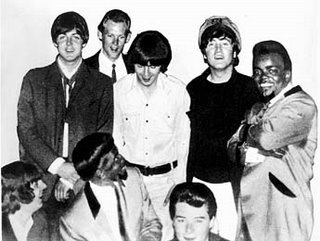
Just Like Me (George and Teddy and The Condors)
The Condors were an interracial San Francisco-based R&B group that featured black singers George and Teddy backed by a white rock band, kind of like a West Coast Booker T. & The MGs. They actually got to meet the Beatles during a tour of Italy in 1965, as pictured above. “Just Like Me” is highlighted by great go-go dancing in gold lame outfits and George and Teddy’s prominent pompadours.
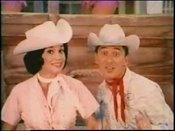
For You (Freddie Bell & Roberta Linn)
Freddie Bell and Roberta Linn exude the kind of schmaltzy Steve-and-Edie Rat Pack Cool perhaps unique to the swinging 60s Las Vegas mindset. And no wonder. In the 50s, Freddie Bell and the Bellboys were the Sands Hotel house band and it was their version of Mama Thornton’s “Hound Dog” that Elvis Presley heard and recorded later for RCA. The Bellboys biggest hit was the novelty tune “Giddy Up a Ding Dong,” which they performed in the first rock & rock film, Rock Around the Clock. Freddie Bell continued to perform in Vegas throughout the 90s. Roberta Linn got her start as Lawrence Welk’s “Champage Lady” and went on to star in various nightclub revues, including a residence at The Sands Hotel. Variety dubbed her “The Best Friend a Song Ever Had.” Trivia: A clip of "For You" was shown during a flashback seaquence on Season 1 of the TV show Lost.
Tweedlee Dee (Freddie Bell & Roberta Linn)
Despite the inane nursery rhyme lyrics, this novelty ditty actually makes golfing look rather sexy and, um, swinging. No wonder rockstars Alice Cooper and Iggy Pop headed for the greens!
The Race Is On (Jody Miller)
Jody Miller covers Don Rollins’ country classic (made famous by George Jones) about romance being a trot around the track, with the memorable lines “Now the race is on and here comes pride up the backstretch/Heartache is going to the inside/My tears are holding back they're tryin' not to fall/My heart's out of the running true love scratched for another's sake/The race is on and it looks like heartaches and the winner loses all.”

Land of 1,000 Dances (April Stevens & Nino Tempo)
April Stevens and her bro Nino Tempo (born Carol and Antonino LoTempio) had a No. 1 hit in 1963 with their duet “Deep Purple,” but it’s this cover of a song made soulfully famous by Wilson Pickett that was deemed scopitone worthy, as pretty gals go through numerous costume changes to illustrate the Pony, the Mashed Potato, the Alligator, the Watusi, the Jerk and the Twist.

Little Miss Go-Go (Gary Lewis & The Playboys)
Hip-shaking cheerleaders in miniskirts and halter tops wave hand-held transistor radios (the essential pre-cellphone accessory of the day) as Jerry’s rockin’ son Gary channels The Beach Boys at a marina.

Pretty Girls (Bobby Vee)
North Dakota-native Bobby Vee (born Robert Velline) was a Brill Building bubblegum pop star whose All-American good looks led to appearances in numerous scopitones and movies in the early 60s. Bobby Vee and his band the Shadows got their start filling in as a replacement band for Buddy Holly & The Crickets following the tragic 1959 "Day the Music Died" plane crash that killed Holly, Richie Valens and The Big Bopper. His band at one point included Bob Dylan, who played piano under the stage name Elston Gunn. In this scope, he objectifies “pretty girls” but in a non-threateningly wholesome manner worthy of a Frankie and Annette beach movie.
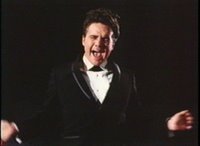
High Boots (Unknown artist – Mr. Eraserhead?)
We have no idea who this guy is, but he’s got a high-voice, high-energy, a high-pompadour and, yup, high boots. What more do you need?

The Twist
This is a random sampling of clips celebrating perhaps THE dance craze of the swinging 60s.


Harley Davidson, Comic Strip and Contact (Brigitte Bardot)
French sex siren/chanteuse Brigitte Bardot sings three songs written by Serge Gainsbourg. “Harley Davidson” is a fairly simple paen to riding motorcycles; “Comic Strip” is a duet with Serge that features Brigitte in a black wig and Barbarella costume; “Contact” is a psychedelic trip to outer space set to a techno beat that anticipates rave culture by some 30 years. All three scopes were featured on her 1968 French TV special, Le Show Bardot.

Land of 1,000 Dances (Danny Whitten)
Danny Whitten is best known as the Crazy Horse guitarist who O.D.ed on heroin and was immortalized on Neil Young’s Tonight’s the Night album. But before “The Needle and the Damage Done,” Danny Boy and Crazy Horse’s Billy Talbot and Ralph Molina were in a doo-wop group called Danny and the Memories. This phase is captured in this rare scopitone from the mid-60s.

The Night Has 1,000 Eyes (Bobby Vee)
Bobby Vee rides scooters in this one. Not as cool as seeing Brigitte Bardot astride a Harley, but still worth the ride.

One Has My Name, The Other Has My Heart (Barry Young)
Dean Martin-wannabe Barry Young sings of his would-be cheatin’ heart and his domestic dilemma - one gal has his name (his doting wife) but the one he really loves (a blond, natch) has his heart. Keep dreaming Barry – chances are the blond would go for Bobby Vee over you, anyway! A one-hit wonder from 1965.
Related Links:
"History of the Scopitone" by Robin Edgerton
Watch scopitones at Scopitones Blog
Watch scopitones on YouTube
Read the history of scopitones at Scopitones Blog
Listen to “Rise and Fall of the Scopitone Jukebox” by Jennifer Sharpe
Scopitone Clips Medley (belletristik on YouTube)
Scopitones entry (Wikipedia)
Schlocker (great Euro a go go music link)
"The Jukebox That Ate Cocktail Lounge" by Jack Stevenson
"Videoclip Story" (Italian documentary on Cinebox & Scopitones)
Scopitones.com
Scopitones Archive
Bedazzled (Scopitone.com's sister site)
No comments:
Post a Comment